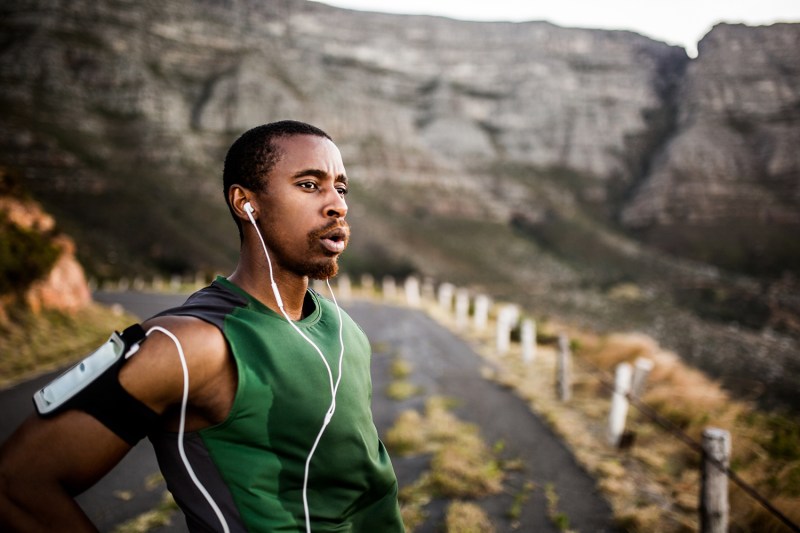
One of the many benefits of running is that it strengthens your lungs – even if it doesn’t feel that way when you’re out of breath or powering through those painful side stitches. If breathing is instinctive during the day but a real struggle while you run, you’re not alone. Experts agree that proper breathing while running is a combination of practice, endurance, and technique (see: Our beginner’s running guide). As you continue to train regularly and apply our handy tips, your lungs will get stronger and your breathing pattern will become the pacer that helps you go the extra mile.
Why Is Breathing While Running So Tough?
Many new runners find themselves gasping for air because they simply don’t know how to control breathing while running. Even if you’re in great shape, you may experience shortness of breath as a result of carbon dioxide building up in your body. This makes your lungs breathe faster as they try to take in more oxygen.
Another cause for panting may be that your diaphragm is tired and needs to build stamina. Pressure on the diaphragm also causes sharp and painful side stitch cramps, which are especially common when you’re just starting out or working to improve your running time.
While feeling out of breath is normal during runs, it’s always best to check with your doctor before starting a new exercise routine. Cardiac disease, respiratory problems and asthma could be some of the reasons for breathlessness during your runs. Once your physician has cleared you to start running, you can apply these tips to help feel great and enjoy your time outside.
How to Control Breathing While Running

The key to breathing while running is in the way you take in your air. For easy jogs, professionals recommend inhaling through the nose and exhaling through the mouth. This breathing technique is ideal to keep a conversation while you jog with your running buddy.
If you find yourself clenching your jaw while you run or squeezing your shoulders up, it’s time to give your lungs a little more oxygen. The way to let more air in is by breathing through both your nose and your mouth. As you increase the amount of oxygen, you’ll notice how your breath slows down and your whole body relaxes – not to mention that it makes for a much more enjoyable workout.
How to Improve Breathing While Running
Embrace Rhythmic Breathing
Once you have the inhale/exhale part down, you’ll feel much better during your runs. To take it to the next level, you can work on your cadence to help your body find a steady pace. It only takes a bit of observation to discover your body’s natural breathing pattern and get your rhythm going.
With experience, many runners find that breathing in takes them a certain number of strides to breathe in and another number of steps to breathe out. If your lungs tend to inhale every 3 steps and exhale after another 3, it’s a good idea to keep this pattern going to help your body achieve a steady pace.
Once your stamina improves, you can start to use your breath as a way to push yourself to run faster. Many runners hack their breathing patterns and take one less step to exhale. Following a 3:2 pattern, for example, speeds your pace and allows you to focus on your breathing rather than the physical effort.
Get a Good Warm Up
Remember how much your high school PE teacher used to drill you about warming up? There’s a reason for that. A solid warm up prepares your diaphragm for strenuous exercise and gets your body breathing deeper. This helps avoid stabbing side pains and also gives your other muscles a chance to prepare for your run.
Practice Breathing Exercises
With simple breathing exercises, you can increase your lung capacity and ensure proper technique while you’re on your runs. When you’re relaxing at home, take the time to sit for a few minutes and take deep inhales that cause your stomach to expand. Hold the air in for a few seconds and then exhale just as deeply. This simple technique is known as belly breathing and it teaches your body the best way to breathe while running.
Hit the Treadmill
If you want to give your breathing a test run before you head outdoors, the treadmill is your best friend. This useful machine lets runners focus on breathing, posture and form from the comfort of their own home. When you run outdoors, you’ll notice a drastic improvement in your overall condition and your rhythmic breathing will feel like second nature.
As you’ve already experienced, running is a physical and mental challenge. It takes patience and perseverance to reach a point where you feel comfortable during your runs. But with the proper techniques, you’ll soon stop feeling out of breath while you run. And once you get control of your breathing, you unlock the power of this Zen sport that gives you time with yourself and makes you feel like you can conquer the world.
Is it better to breathe through your nose or mouth while running?
Experts recommend breathing through your nose and mouth while running. Since the nostrils are a narrow passageway, letting some air in through your mouth increases the amount of oxygen that enters your lungs. Exhaling through both also allows for quicker recovery and greater endurance.
Why do I struggle to breathe when running?
It’s normal to feel out of breath while you run. This happens because your body is making a big effort that causes carbon dioxide to accumulate in your lungs. In order to let more oxygen in, your lungs start to breathe with greater intensity. As your diaphragm gets stronger and you get in better shape, you’ll be able to breathe more easily while you run.
Health conditions could also cause difficulty breathing during runs. Don’t hesitate to contact your physician if you’re concerned about your health or experience symptoms such as wheezing, dizziness or fainting as these could be warning signs that require medical attention.
What’s the best way to breathe while running and wearing a face mask?
With the spread of COVID-19 still ongoing, it’s important to wear a workout face mask while running if your route or trail involves the risk of being around others. The CDC advises the use of masks in public settings, but if you’re having trouble breathing during high-intensity workouts, they recommend moving to a different location with better air circulation and distance from others and exercising without a mask. If you’re running and experience symptoms such as dizziness or shortness of breath, stop what you’re doing and get to a place where you can remove your mask safely. If you’re running and your mask gets wet, be sure to change it, as it may be more difficult to breathe through.
Running while wearing a mask can make workouts more challenging, but as long as you keep your workouts on the low-to-medium difficulty level, you should be able to run comfortably. Save the HIIT workouts or sprints for an area with better ventilation so you can avoid breathing heavily in your mask. If you feel out of breath, slow down or stop to take a break, removing your mask when it’s safe to do so.
The best masks to wear while running are ones that are lightweight and made from a moisture-wicking fabric. The mask should fit snugly on your face, covering your nose and your chin. You may want to look into a mask with an adjustable nose strip that can mold to the bridge of your nose to keep it from falling down during your run. Remember to always wash your mask after exercising, and if you plan on going on a long run, consider packing an extra mask in case the first one gets wet from sweat or moisture.



